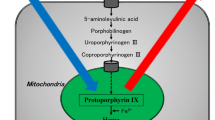Abstract
In penile cancer there is still a diagnostic dilemma between over treatment of lymph node-negative patients and the missing of occult metastases by watchful waiting. In the current study the value of fluorescence diagnosis during radical inguinal lymph node dissection was evaluated. Five patients with penile cancer were elected to undergo groin dissection. All patients received 5-aminolevulinic acid (5-ALA) orally before the operation for fluorescence diagnosis. Intraoperatively, fluorescence detection of the lymph nodes was performed by visual detection and spectroscopy. Two of the five patients had positive inguinal lymph nodes. Fluorescence in tumor-bearing tissue was detectable in the exposed lymph nodes. Protoporphyrin IX (PPIX) is accumulated in tumor-positive lymph nodes, making fluorescence diagnosis in penile cancer possible. More studies with higher patient numbers are necessary to evaluate optimal dosage and excitation conditions to detect tumor-bearing nodes in vivo.
Similar content being viewed by others
References
Brkovic D, Kalble T, Dorsam J, Pomer S, Lotzerich C, Banafsche R, Riedasch G, Staehler G (1997) Surgical treatment of invasive penile cancer—the Heidelberg experience from 1968 to 1994. Eur Urol 31:339–342
Cabanas RM (1977) An approach for the treatment of penile carcinoma. Cancer 39:456–459
Canis M, Botchorishvili R, Berreni N, Manhes H, Wattiez A, Mage G, Pouly JL, Bruhat MA (2001) 5-aminolevulinic acid-induced (ALA) fluorescence for the laparoscopic diagnosis of peritoneal metastasis. Surg Endosc 15:1184–1186
Catalona WJ (1988) Modified inguinal lymphadenectomy for carcinoma of the penis with preservation of saphenous veins: technique and preliminary results. J Urol 140:306–310
Cloberg JW, Andriole GL, Catalona WJ (1997) Long-term follow-up of men undergoing modified inguinal lymphadenectomy for carcinoma of the penis. Br J Urol 79:54–57
Daeseler EH, Anson BH, Reimann AF (1948) Radical excision of the inguinal and iliac lymph glands: a study based upon 450 anatomical dissections and upon supportive clinical observations. Surg Gynecol Obstet 87:779
Frimberger D, Zaak D and Hofstetter A (2000) Endoscopic fluorescence diagnosis and laser treatment of transitional cell carcinoma of the bladder. Semin Urol Oncol 18:264–272
Horenblas S, vanTinteren H, Delemarre JF, Moonen LM, Lustig V, Kroger R (1991) Squamous cell carcinoma of the penis: accuracy of tumor, nodes and metastasis classification system, and role of lymphangiography, computerized tomography scan and fine needle aspiration cytology. J Urol 146:1279–1283
Horenblas S, van Tinteren H, Delemarre JF, Moonen LM, Lustig V, van Waardenburg EW (1993) Squamous cell carcinoma of the penis. III. Treatment of the regional lymph nodes. J Urol 149:492–497
Horenblas S, Jansen L, Meinhard W, Hoefnagel CA, de Jong D, Nieweg OE, Theodorescu D (2000) Detection of occult metastasis in squamous cell carcinoma of the penis using a dynamic sentinel node procedure. J Urol 163:100–104
Hussein A, Benefetto P, Sridhar KS (1990) Chemotherapy with cisplatin and 5-fluouracil for penile and urethral squamous cancers. Cancer 65:433–438
McDougal WS (1995) Carcinoma of the penis: improved survival by early regional lymphadenectomy based on histologic grade and depth of invasion of the primary lesion. J Urol 154:1364–1366
Mobilio G, Ficarra V (2001) Genital treatment of penile carcinoma. Curr Opin Urol 11:299–204
Ornellas AA, Seixas AL, Marota A, Wisnescky A, Campos F de Moraes JR (1994) Surgical treatment of invasive squamous cell carcinoma of the penis: retrospective analysis of 350 cases. J Urol 151:1244–1249
Perinetti EP, Crane DB, Catalona WJ (1980) Unreliability of sentinel lymph node biopsy for staging penile carcinoma. J Urol 124:734
Persky L, De Kernion J (1986) Carcinoma of the penis. CA Cancer J Clin 36:258–273
Pizzocaro G, Piva L, Bandieramonte G, Tana S (1997) Up-to-date management of the carcinoma of the penis. Eur Urol 32:5–15
Schneede P, Frimberger D, Zaak D, Hofstetter A (2001) Fluorescence diagnosis of penile carcinomas—a new technique to assist and control Nd:YAG laser therapy. Med Laser Appl 16:43–48
Steinbach P, Kriegmair M, Baumgartner R, Hofstaedter F, Knuechel R (1994) Intravesical instillation of 5-aminolevulinic acid: the fluorescent metabolite is limited to urothelial cells. Urology 44:676–681
Wawroschek F, Vogt H, Bachter D, Weckermann D, Hamm M, Harzmann R (2000) First experience with gamma probe guided sentinel lymph node surgery in penile cancer. Urol Res 28:246–249
Wespes E, Simon J, Schulman CC (1986) Cabanas approach: is sentinel lymph node biopsy reliable for staging penile carcinoma? Urology 28:278–279
Author information
Authors and Affiliations
Corresponding author
Rights and permissions
About this article
Cite this article
Frimberger, D., Linke, R., Meissner, H. et al. Fluorescence diagnosis: a novel method to guide radical inguinal lymph node dissection in penile cancer. World J Urol 22, 150–154 (2004). https://doi.org/10.1007/s00345-003-0352-1
Received:
Accepted:
Published:
Issue Date:
DOI: https://doi.org/10.1007/s00345-003-0352-1




